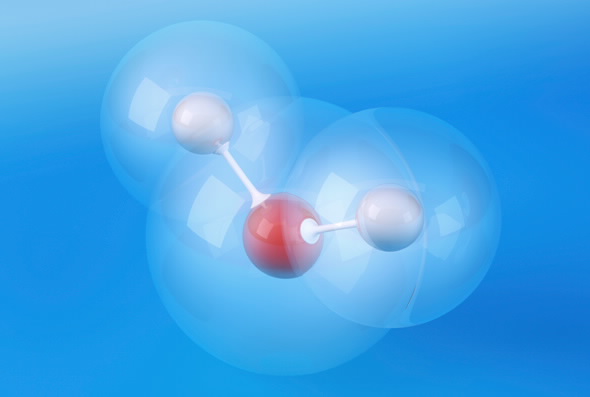Water is an incredibly important component of any biological system and understanding its role is crucial when you are analysing biological activity at the macromolecular level, according to Bragg Institute Instrument Scientist, Kathleen Wood.
 |
“We’ve been using nuclear techniques and other methods to clarify the role of water hydration in activating proteins,” said Wood.
Proteins are important because they are large, complex molecules that have many crucial roles in the body. They are studied extensively in the life sciences because of their importance in health. Proteins can be folded into a complex three dimensional structure or exist without a single well-defined structure in their native state (intrinsically disordered). |
The study is relevant for the development of therapeutic drugs that are formulated as solids. Reactions can occur in the solid state, which lead to the degradation and inactivation of these agents.1
Wood is one of a large group of collaborators led by Giorgi Schiro of the Institute of Structural Biology in Grenoble, France, who have published a paper in Nature Communications that elucidates how water molecules interact with the surface layer of folded and intrinsically disordered types of proteins at specific temperatures.
Other investigators came from CEA, the CNRS, the Institut Laue-Langevin, the Forschungszentrum Jülich, the University of California Irvine, the Max Planck Institute Mülheim and the University of Perugia.
Other investigators came from CEA, the CNRS, the Institut Laue-Langevin, the Forschungszentrum Jülich, the University of California Irvine, the Max Planck Institute Mülheim and the University of Perugia.
Water is the primary constituent of our bodies and soluble proteins cannot function without their surrounding hydration layer. Hydration water takes part in macromolecular activity such as protein-protein and protein-DNA recognition, binding, electron and proton transfer and enzyme reactions. 2
Although it was known that a soluble protein needed to be covered with water to become biologically active, the exact mechanism by which this was achieved was not understood.
Although it was known that a soluble protein needed to be covered with water to become biologically active, the exact mechanism by which this was achieved was not understood.
The authors found evidence that it was water’s ability to flow on the surface of a protein that made it sufficiently dynamic to carry out a function. Looking at the surface layer is important because it is the key to the protein maintaining its structure, flexibility and lubrication for movement.3
The water molecules rotate around their own axes below - 30⁰C and, above that temperature, continue rotating but also start to undergo translational diffusion, the breaking of water-water bonds at a distance from the surface. These translational motions must occur in the water for the protein to fulfil its biological function.
Wood used a method known as incoherent quasi elastic neutron scattering (QENS) to acquire detailed information on the movement and local arrangement of water atoms and two proteins: the human protein tau and globular maltose binding protein.
Incoherent scattering relates to scattering by individual atoms: if the atoms or molecules undergo translational or rotational diffusion during the scattering event, this single-particle scattering is accompanied by the transfer of energy to or from the neutrons.
“Quasi elastic neutron scattering is a useful technique because it allows us to investigate how water molecules are moving on relevant timescales,” said Wood.
There was experimental evidence that rotation and translation were temperature-dependent and that the change in hydration water dynamics occurred at -33⁰C; this is known as the protein dynamical transition.
Computational simulations reproduced the onset of translational water diffusion seen in the experiments and allowed the scientists to examine the way water moves in more detail.
The QENS measurements were carried out on the SPHERES backscattering instrument at the Heinz-Maier Leibnitz Zentrum in Garching Germany. ANSTO’s high resolution backscattering instrument Emu had not been commissioned at the time of the study. Wood said that when it comes online later this year it will be one of only four instruments in the world that can do these types of measurements.
Wood was the key investigator and a joint collaborator on two previous papers that focused on the complex energy landscape of proteins and their relation to function through temperature and hydration dependent transitions.
“I was working with Martin Weik of the Institute of Structural Biology in Grenoble, who has done important work on the hydration influence on protein dynamics. This earlier work also used neutron scattering and led the investigators to better understand the coupling between water and protein dynamics.
“Although I studied physics, I collaborate extensively with chemists and biologists to look at problems of biological relevance, such as molecular activity on the surface of a protein.”
- Lai, M.C Topp, E.M. Solid-state chemical stability of proteins and peptides. J Pharm Sci. 1999 May;88(5):489-50
- Ball, P. Water as an active constituent in cell biology, Chem Rev. 2008 Jan; 108(1):74-108
- Zhang, L. Wang, L. Kao, Y. T. Qiu, W. Yang, Y. Okobiah, O. Zhong, D. Mapping hydration dynamics around a protein surface, Proc Natl Acad Sci U S A. 2007 Nov 20;104(47):18461-6
doi:10.1038/ncomms7490
Published: 03/06/2015


